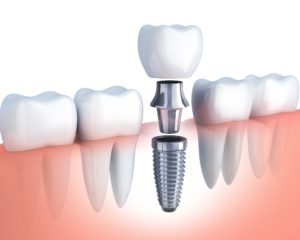What Are Dental Implants Made Of?

You’ve been missing a tooth for a while now. By now you’ve gotten used to the fact that you can’t chew delicious steak on that side of your mouth anymore. But what if it didn’t have to be that way? You could replace that missing tooth with a dental implant. They’re a convenient and permanent solution to tooth loss. But what exactly are they made of? Let’s look more closely at the anatomy of dental implants.
What Are Dental Implants?
Dental implants are posts, usually made of metal, that are designed to mimic the root of a missing tooth. They are surgically inserted directly into the jawbone to replace teeth. Over time, the implant attaches to your jawbone and functions like the root of your natural tooth did. Implants have advantages over other methods of tooth replacement. They can’t come loose as dentures can, and unlike bridges, they don’t have to be anchored to other teeth. Additionally, they are designed to be permanent, and with regular brushing and flossing, they can last for the rest of your life!
Once the implant is properly placed, your dentist in Valparaiso can place a crown on top to make it resemble a natural tooth, and an abutment to connect them. Let’s take a closer look at the 3 parts of a dental implant.
1. The Implant Itself
The implant, also known as the fixture, is the part that is surgically placed beneath the gum line. Then your implant fuses to your jawbone in a process called osseointegration. Once this process is complete, your implant will basically be part of your own anatomy.
Implant fixtures are almost always made of titanium, due to its being strong yet lightweight. Additionally, the human body almost never rejects it. There are some circumstances where the patient has an allergy to titanium, so the implant is then made of another material, usually zirconium or ceramic.
2. The Crown on Top
The crown, also called the restoration or prosthesis, is the part of the implant that looks like a real tooth. It’s usually made of porcelain or ceramic, and can even be customized the match the shade of the rest of your teeth so that it can naturally blend into your smile. The crown is attached to the implant with an abutment.
3. The Abutment That Connects Them
Since the implant itself lies entirely underneath the gumline, a device must be placed that allows it to connect with the crown. This is called an abutment. It’s a short screw that extends slightly above the gum line to support the restoration. The abutment is typically made from metal or tooth-colored material and is usually not attached until osseointegration is complete so the implant has enough time to heal and settle. However, sometimes a dentist will determine that it is ideal to place all 3 elements of the implant at the same time.
Hopefully, this guide makes dental implants not sound so scary anymore! For more questions about how implants can fill the gaps in your smile, contact your local implant dentist.
